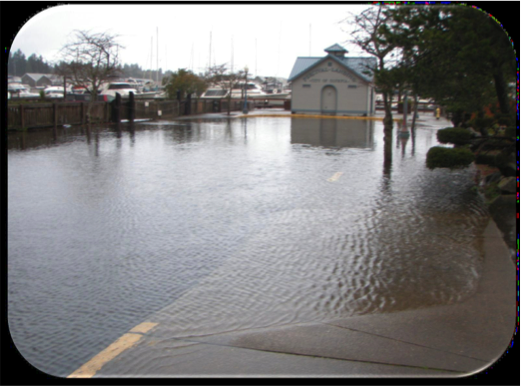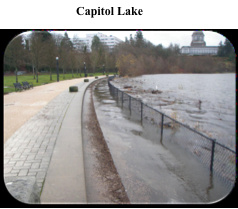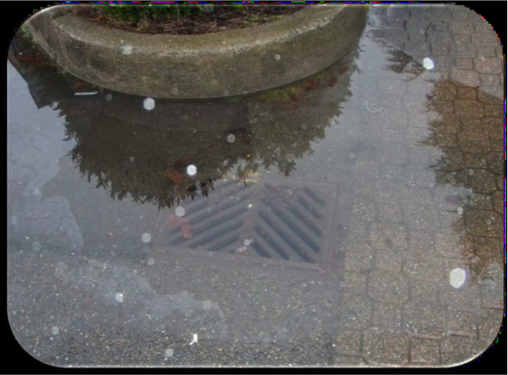Potential consequences of sea level rise in Olympia
Greater risk of flooding
 Since many parts of Olympia’s downtown
are only a few feet above the current high-tide water level
already, a rise in sea level could cause flooding in parts
of the city like the Port of Olympia and the waterfront
business district, as well as Capitol Lake. Higher water
levels would also increase the risk of high-tide flooding
and a greater risk for storm damage. 50 or 100-year storms
could increase in frequency, causing greater damage to
coastal areas [1]. Olympia already has experience with these
events, such as the 17.6 foot (5.4 m) tide on December 17,
2012 (pictured at left) [2].
Since many parts of Olympia’s downtown
are only a few feet above the current high-tide water level
already, a rise in sea level could cause flooding in parts
of the city like the Port of Olympia and the waterfront
business district, as well as Capitol Lake. Higher water
levels would also increase the risk of high-tide flooding
and a greater risk for storm damage. 50 or 100-year storms
could increase in frequency, causing greater damage to
coastal areas [1]. Olympia already has experience with these
events, such as the 17.6 foot (5.4 m) tide on December 17,
2012 (pictured at left) [2].
Inundations of the sewer and storm water system
Higher water table
In much of downtown Olympia, the
water table is only about a foot beneath the ground surface in
winter months. Sea level rise could cause the water table to
rise, possibly to the point where during extreme storm events
the water table could reach ground level. This could exacerbate
flooding as flood waters would recede more slowly with nowhere
to drain. A higher water table could also negatively affect
building foundations and pavements, as well as pose a danger to
underground storage tanks storing hazardous material,
dozens of which are located in the vulnerable Port of Olympia
and downtown areas [4].
Shoreline erosion and habitat loss

Sea level rise will increase the amount and speed of erosion along the shoreline of Budd Inlet as well as the risk of landslides. In low-lying areas, there will be more frequent flooding and damage to infrastructure. Marshy shorelines will experience increased flooding and erosion, and loss of salt marsh and similar habitat will depend on constraints of surrounding development. Construction of protective structures like seawalls and dikes in vulnerable areas will also lead to beach and marsh habitat loss, which will affect many species within those habitats. Sea level rise could also disturb other coastal ecosystems by moving tidal inlets, stream mouths, estuaries and wetlands [5].
Salinization of water supplies
McAllister Springs, Olympia’s main drinking water
source, is vulnerable to saltwater intrusion with rising sea
levels. Olympia has planned to shift this supply to the
McAllister Wellfield, a few miles upgradient and less vulnerable
to saltwater intrusion by 2014, however other natural freshwater
systems are at risk for salinization, endangering habitat and
the species that live within them [6].
[1] Washington Dept of Ecology. Shoreline Master Program Guidebook. Pg. 3.
[2] Haub, A. (2013). Community Update on Sea Level Rise. Powerpoint presentation. City of Olympia.[3] McGowen, V. (2007). Climate Change – Olympia is Concerned. City of Olympia.
[4] Craig, D. (1993) Preliminary Assessment of Sea Level Rise in Olympia, Washington: Technical and Policy Implications. City of Olympia. Pg. 16.
[5] Craig, D. (1993) Preliminary Assessment of Sea Level Rise in Olympia, Washington: Technical and Policy Implications. City of Olympia. Pg. 4.
[6] McGowen, V. (2007). Climate change – Olympia is concerned. City of Olympia.
Contact: peter (at) stat.washington.edu
